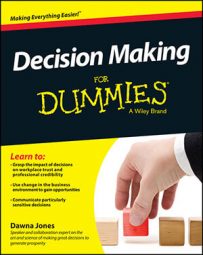If you attended business school, chances are you were taught only about rational decision-making processes. Traditional business schools emphasize the use of the rational approach, assuming that the business world is predictable. Unfortunately, it isn’t.
Rational approaches have their application, but in unpredictable, fast-moving, complex, and high-stakes environments, you get faster and more accurate decisions when you use intuition. The highest performing and longest running companies in the world are both intellectually and intuitively intelligent.
Applying rational and intuitive approaches to your decisions is a lot like a dance. Which one leads? Which one follows? The answer depends on the kind of decision and the situation you’re dealing with. Following are some general guidelines regarding how to balance intuition and rational decision-making in various situations. Keep in mind that these are very general guidelines; every situation you encounter will be unique:
In fast-moving, rapidly changing, high-stakes situations, let your intuition take over. There’ll be no time for any other intervention. Although the chance always exists that more information could surface, the decision can’t wait. Executives or entrepreneurs making bold, high-risk decisions face this kind of situation all the time. You need to trust your instincts and stay committed to expanding your thinking to avoid narrow reasoning.
For many years, the U.S. military subscribed to an approach that required using analysis to think things through. Then in 2003, it endorsed applying intuition when it realized that over 90 percent of the decisions being made were made intuitively.
In start-up companies under pressure to move ideas forward while achieving a positive cash flow, you often engage in a messy blend of intuition, analytics, and flying by the seat of the pants. In fact, you may be totally unaware of how you’re making your decisions. Under these circumstances, coming to agreement on how you’ll decide is a good idea.
Considering that the failure rate of start-ups is ridiculously high, slowing down to be aware of how you’re deciding may make your company one that makes it through.
If you’re an entrepreneur who makes one high-stakes decision after another, consider delegating or sharing decision-making, using a more systemized method understood by all decision-makers in the company. Doing so will relieve some pressure and bring a sense of order to what can feel like total chaos.
This approach also reserves intuitive and intellectual energy for responding to the bigger questions like, for instance, whether you accept an offer to buy your company out.
If your job requires adherence to specific regulatory or technical standards, you initially use the rational approach to follow formal procedural guidelines. As you gain experience, however, you can improve your add decision-making speed and accuracy by applying intuition.
The higher the stakes and the more important the decisions are, the less time you have to make them. Let your intuitive supercomputer blend the facts with other information you’ve picked up through the social and emotional environment. Doing so gives you a strong sense of how the decision aligns with your core purpose and values.
Successful entrepreneurs and executives use their intuition as a shortcut to make sense out of vast amounts of factual and sensory information. They have an innate sense of whether they are on the right path and can readily adapt to surprises.
If you make decisions under public or regulatory scrutiny — often the case in situations where accountability for public (or investor) funds is required — use a rational approach to ensure you’ve done your due diligence. This kind of approach makes the decision-making process transparent and ensures that you cover all the required bases.
Remember, however, that the more complicated a decision is, the longer applying a rational approach takes. Use your best judgment to weigh time and complexity with speed and accuracy.
If the decision is being made with remote, intact, or interdisciplinary teams or partnerships, start with an intuitive take, then explore a rational approach to make the decision, and follow up with confirming the decision using collective intuition. This strategy is best because participants in a multiparty decision-making process often represent and are accountable to their own managers, agencies, business units, or to the public.
Rationally thinking the decision through together strengthens the relationship and provides a forum for the interests, needs, and diverse views of the participants to be considered; it also provides all with the information needed to communicate proceedings to those who need to know.
These are broad guidelines, so use your judgment to adopt an approach that best suits each situation you encounter. And don’t forget that this isn’t an either/or game. The best approach is to blend the intuitive with the rational to make good decisions. Which of the two takes precedence depends on the circumstances.
The process you choose has an impact on support for the final decision. Collective support helps everyone be on the same page when communicating the decision and throughout its implementation, particularly when things don’t go according to plan. It is well worth the time to ensure that everyone has achieved a comfort level with the result, that their concerns have been addressed, and that their expertise has been incorporated into the final outcome.

